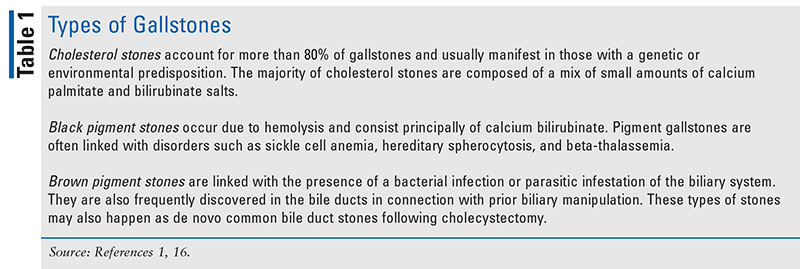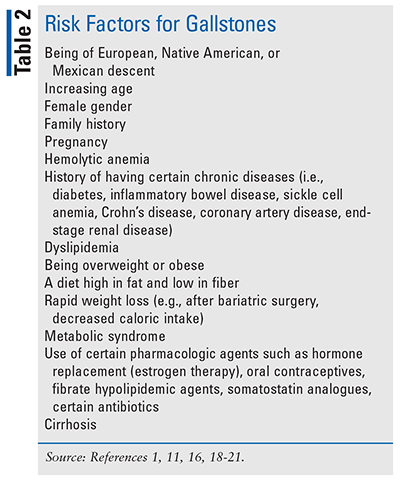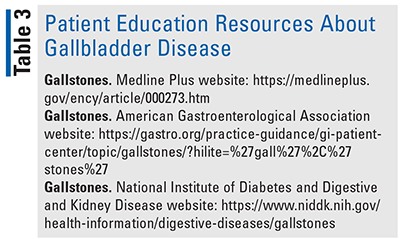US Pharm. 2020:45(12):HS-2-HS-10.
ABSTRACT: In the United States, an estimated 20 million people have gallstones, termed cholelithiasis, with women being two to three times more likely to have them compared with men. Cholelithiasis is a costly digestive disease for the healthcare system; the pain associated with it is a common reason for emergency department visits. Patients with chronic cholelithiasis may develop cholecystitis, which can be acute or chronic. Gallstones are most commonly diagnosed using ultrasound. Treatment depends on patient symptoms, other comorbidities, and overall health. Treatment for cholelithiasis may involve surgery or medical management with oral bile acids. Treatment of cholecystitis depends on the patient’s presentation and the severity of the condition.
Cholelithiasis, commonly known as gallstone disease, is defined as the presence of one or more gallstones in the common bile duct.1,2 Gallstones are hardened deposits of the digestive fluid, bile, and can differ in size and shape.3 Patients may present with gallstones that are as small as a grain of sand or as big as a golf ball; patients may have one huge gallstone, hundreds of tiny stones, or a mixture of both sizes.3 Gallstones are composed of cholesterol and calcium bilirubinate.1
Cholesterol gallstones account for about 80% of cholelithiasis cases.1 The types of gallstones are described in TABLE 1.

Patients with chronic gallstones may develop progressive fibrosis and loss of motor function of the gallbladder, resulting in cholecystitis, an inflammation of the gallbladder.4,5 Cholecystitis can be acute or chronic, with recurrent episodes of acute inflammation possibly leading to chronic cholecystitis, the most common complication associated with gallstones.5 Cholelithiasis is linked with 90% to 95% of chronic cholecystitis cases.1,5 Limited data suggest that individuals with chronic cholecystitis have a higher risk of developing gallbladder cancer, possibly due to the fact that both conditions are related to inflammation.6,7
CHOLELITHIASIS
Incidence
In the United States, the Third National Health and Nutrition Examination Survey reported that 20 million people—approximately 6.3 million males (6%) and 14.2 million females (9%)—have cholelithiasis.8,9 The highest incidence is reported among Hispanic men and women, 8.9% and 26.7%, respectively; followed by non-Hispanic white men and women, 8.6% and 16.6%, respectively; and non-Hispanic black men and women, 5.3% and 13.9%, respectively.8.9 The incidence of gallstones appears to be greatest in persons of northern European descent and in Hispanic and Native American populations; incidence is lower among Asians and African Americans.10,11
Cholelithiasis is the most common inpatient diagnosis among gastrointestinal- and hepatic-disease patients.12,13 It is also one of the most expensive digestive diseases for the healthcare system and is the most frequent cause of death from nonmalignant disease of the gastrointestinal tract.9
An estimated 500,000 individuals present with symptoms or complications of cholelithiasis that warrant a cholecystectomy, the removal of the gallbladder.1 Pain from gallstones is one of the most common causes for emergency department (ED) visits; determining which patients need surgery can sometimes be challenging for clinicians.14 One study found that one in five patients who went to the ED with gallbladder pain and were sent home to schedule surgery returned to the ED within 30 days requiring a cholecystectomy; the rate of surgical complications increased with the time before the surgery.14
The incidence of cholesterol gallstones is increasing, concurrent with an increase in several metabolic abnormalities, such as insulin resistance and type 2 diabetes, expansion of visceral adiposity due to overweight and obesity, and metabolic syndrome.15
Risk Factors
Risk factors for cholelithiasis can be classified as genetic or environmental, and further classified as modifiable and nonmodifiable.1,2,16 In addition to ethnicity, gender is also a risk factor. Females are more prone to develop cholesterol gallstones when compared with males, particularly during their reproductive years, with the greatest prevalence, 73%, occurring between the ages of 25 and 34 years.17 During the reproductive years, the prevalence of gallstones in females can be two to three times higher than males, likely due to the presence of estrogen, which enhances the secretion of biliary cholesterol.17 Additional risk factors are described in TABLE 2.
Diagnosis
Patients with cholelithiasis may go undiagnosed because the majority of cases (80%) are often asymptomatic and are usually discovered incidentally during routine imaging for other abdominal conditions.18-20 An estimated 10% of patients will develop symptoms within 5 years of a diagnosis of gallstones; 20% of patients will develop symptoms, and possibly clinically substantial complications as a result, within 20 years.1,19
Cholelithiasis is typically diagnosed with ultrasonography.2,5,21 Laboratory tests are not usually helpful because results are often normal, unless complications develop.2 When imaging is done for other diagnostic purposes, asymptomatic gallstones and biliary sludge are often noticed incidentally; an estimated 10% to 15% of gallstones are calcified and noticeable on plain x-rays.2,5
Treatment
Typically, patients with asymptomatic cholelithiasis do not warrant therapy unless an issue arises. Expectant management is recommended for asymptomatic stones; recommended treatments for symptomatic stones include laparoscopic cholecystectomy or, sometimes, stone dissolution using ursodeoxycholic acid (UA).2,13
Surgery: If surgery is warranted, it can be performed using laparoscopic or open technique. Laparoscopic cholecystectomy is considered the treatment of choice.2,14 Open surgery may be suggested when concomitant gallbladder cancer is present.1,22 Supportive care for those undergoing surgery may include IV fluids, pain control, and IV antibiotics.5,23 Antibiotics are frequently administered prophylactically to protect against sepsis and wound infection.23 When empiric antibiotic therapy is indicated, the selected antimicrobial agent should cover the most frequent pathogens of the Enterobacteriaceae family, including gram-negative rods and anaerobes.23 In some cases, patients may decline surgery for reasons such as the uneasiness about surgery, healthcare expense, and loss of productivity and/or concerns about the risks of elective surgery.2
Oral Bile Agents: For patients who decline surgery or for those who may be at higher surgical risk because of other comorbidities or advanced age, clinicians may elect to use oral bile acids.1,2 It is important to note that medical management of gallstones with pharmacologic therapies has diminished in the past few years.1 Medical therapy that is used alone or in combination may include oral bile salt therapy, such as UA, which is often used for x-ray–negative cholesterol gallstones in patients with normal gallbladder function.1 Extracorporeal shockwave lithotripsy may also be used, particularly in patients with noncalcified cholesterol gallstones who have normal gallbladder function.1
Optimal candidates for oral bile agents include patients with the following:24
• Small stone size (<1 cm)
• Minimal stone calcification and high cholesterol concentration
• Minor symptoms of uncomplicated gallstone disease (biliary colic)
• Patent cystic duct
• Good gallbladder mucosal concentration function
In addition to UA, another available oral bile agent is chenodeoxycholic acid (Chenodiol). The most commonly prescribed oral bile agent is UA, which dissolves gallstones by solubilizing cholesterol from the surface and center of the gallstone.24 This agent has a safer adverse drug reaction profile when compared with chenodeoxycholic acid.24,25
The use of chenodeoxycholic acid is limited because it is linked with dose-dependent diarrhea, hepatotoxicity, hypercholesterolemia, and leukopenia.25 Chenodeoxycholic acid also has an FDA Boxed Warning indicating that due to its potential hepatotoxicity, poor response rate in some subgroups of chenodeoxycholic acid–treated patients, and an augmented rate of cholecystectomy in other chenodeoxycholic acid–treated subgroups, chenodiol is not a suitable treatment for many patients with gallstones.25 Chenodeoxycholic acid should be reserved for meticulously selected patients, and treatment must be accompanied by systematic monitoring for liver-function variations. It is also contraindicated in pregnancy (category X).25
UA is generally prescribed at a dose of 8mg/kg to 10 mg/kg daily in two to three divided doses; use beyond 24 months has not been established.24,26,27 Administration in divided doses aids in preserving hepatic bile-acid secretion overnight, diminishes secretion of supersaturated bile, and augments rates of stone dissolution.24,26,27 Patients should be monitored for hepatic function monthly for the first 3 months and every 6 months thereafter or as medically necessary.24,26,27 This agent should not be administered with aluminum-based antacids or bile-acid sequestrants. However, if these agents are necessary, patients should be advised to administer aluminum-based antacids 2 hours after taking UA, and to take UA 1 hour before, or 4 to 5 hours after, taking bile sequestrants.26,27 The most common adverse effects associated with this agent include headache, dizziness, diarrhea, dyspepsia, nausea/vomiting, back pain, and upper-respiratory-tract infections.26,27 UA is assigned drug pregnancy category B, and caution should be used in women who are lactating.26,27
CHOLECYSTITIS
Diagnosis
Cholecystitis is typically diagnosed via blood tests, abdominal ultrasound, endoscopic ultrasound, CT scan, or a hepatobiliary scan, cholescintigraphy, if ultrasonography results are equivocal or if acalculous cholecystitis is suspected.5 The distinctive findings associated with acute cholecystitis on ultrasonography include enlargement of the gallbladder, thickening of the gallbladder wall, existence of pericholecystic fluid, and tenderness caused by the ultrasound probe over the gallbladder (sonographic Murphy sign).21
Acute Cholecystitis: Acute cholecystitis is a sudden inflammation of the gallbladder that develops over hours, typically because a gallstone impedes the cystic duct.5 Symptoms include right upper quadrant pain and tenderness; patients may also present with fever, chills, nausea, and vomiting.5 The majority of patients (≥95%) with acute cholecystitis have cholelithiasis.5 Risk factors for cholecystitis are considered to be analogous to the risk factors for cholelithiasis.1,2
In older patients, symptoms of cholecystitis may be vague (e.g., anorexia, vomiting, malaise, weakness), and fever may be absent.5 Although acute cholecystitis resolves spontaneously in 85% of patients without therapy, localized perforation or another problem develops in 10%.5 Acute cholecystitis may also be confused with other illnesses, such as peptic ulcer disease, irritable bowel syndrome, and cardiac disease.1 Chronic and acute pancreatitis can also imitate cholecystitis.1
Chronic Cholecystitis: Chronic cholecystitis is a long-standing inflammation of the gallbladder.28 Repeated episodes of acute cholecystitis may result in chronic cholecystitis and may cause thickening and shrinking of the gallbladder wall, resulting in a failure to store bile. The major symptom of chronic cholecystitis is usually intermittent pain. Upper abdominal pain, often localized to the right upper quadrant, is the most common symptom.28 However, some individuals may be asymptomatic. Upper abdominal tenderness may be present, but typically fever is not. Fever suggests acute cholecystitis.28 Once episodes start, they are likely to reoccur.22
Acute Acalculous Cholecystitis (AAC): AAC is an inflammatory disease of the gallbladder without evidence of gallstones or obstruction of the cystic ducts.28 An estimated 2% to 15% of cases of cholecystitis are acalculous and typically arise in very sick hospitalized patients. The precise causal mechanism is not clear.29 Acalculous cholecystitis is correlated with a greater mortality rate, estimated at 45%, due in part to serious underlying medical conditions and delayed diagnosis.29 It accounts for 5% to 10% of cholecystectomies done for acute cholecystitis.5
Risk factors for AAC include serious illness (e.g., major surgery, burns, sepsis, or trauma), protracted fasting, or total parenteral nutrition, both of which predispose to bile stasis, shock, vasculitis, and a history of immune deficiency.5 Patients with ACC are often possibly septic and are in an ICU setting. They often exhibit an abrupt onset of symptoms of severe right upper abdominal pain; a palpable distended gallbladder may also be present. Leukocytes are usually, but not always, elevated.29
Treatment
Treatment of cholecystitis often depends on the patient’s presentation, severity of the condition, and the presence or absence of complications.30 Uncomplicated cases are often treated on an outpatient basis, with appropriate analgesics; antibiotics, such as levofloxacin (500 mg po qd) and metronidazole (500 mg po bid), to provide prophylactic coverage of the most common organisms. Patients should receive vital follow-up care, and should be advised to contact their primary care doctor with any concerns. Complicated cases may require a surgical approach.30
Surgery: The standard surgical treatment for chronic cholecystitis is elective laparoscopic cholecystectomy, which is associated with low morbidity and can be done as an outpatient surgery.1 Open cholecystectomy necessitates hospital admission and lengthier recovery time.1 Open cholecystectomy is often suggested in patients who are not laparoscopic candidates, such as those with extensive prior surgeries and adhesions.1 In certain patients whose medical condition makes cholecystectomy too difficult, a more minimal procedure, cholecystostomy, which involves inserting a tube into the gallbladder, may be performed.1
Antibiotics: Antibiotics used to treat acute cholecystitis empirically target gram-negative enteric organisms and involve IV regimens (e.g., ceftriaxone 2 g every 24 hours plus metronidazole 500 mg every 8 hours; piperacillin/tazobactam 4 g every 6 hours; or ticarcillin/clavulanate 4 g every 6 hours).5 Patients should be screened for drug allergies and contraindications prior to administration.
Conclusion
Gallbladder disease is a common occurrence in the U.S. Fortunately, most cases can be effectively treated without complications. Pharmacists should be prepared to answer patient questions about gallbladder disease (see TABLE 3 for patient-education resources).
Pharmacists can be instrumental in identifying patients who may be at risk for, or patients exhibiting, signs of cholelithiasis and cholecystitis. They can also encourage those patients to seek further care from their primary healthcare provider when warranted. Pharmacists can educate patients on the typical clinical presentation associated with symptomatic cholelithiasis and cholecystitis as well as the associated risk factors. Pharmacists can recognize pharmacologic agents and medical conditions that may increase a patient’s risk of gallbladder disease and make clinical recommendations accordingly. In cases where pain management is needed, they can also make clinical recommendations regarding appropriate pain control, especially after a cholecystectomy. Moreover, pharmacists can remind patients to discuss their concerns with their primary healthcare provider regarding how to reduce their risk via proper diet, losing weight if warranted, controlling associated diseases, and implementing strategies to reduce other modifiable risk factors for gallbladder disease.
The content contained in this article is for informational purposes only. The content is not intended to be a substitute for professional advice. Reliance on any information provided in this article is solely at your own risk.
REFERENCES
1. Heuman D. Gallstones (cholelithiasis). Medscape. Updated April 1, 2019. https://emedicine.medscape.com/article/175667-overview. Accessed September 30, 2020.
2. Lindenmeyer C. Cholelithiasis. Merck Manual Professional Edition. Updated March 2020. www.merckmanuals.com/professional/hepatic-and-biliary-disorders/gallbladder-and-bile-duct-disorders/cholelithiasis. Accessed September 30, 2020.
3. National Institute of Diabetes and Digestive and Kidney Disease. Definition and facts for gallstones. www.niddk.nih.gov/health-information/digestive-diseases/gallstones/definition-facts. Accessed October 1, 2020.
4. Jones M, Weir CB, Ghassemzadeh S. Gallstones (cholelithiasis). StatPearls. National Center for Biotechnology Information. Updated September 10, 2020. www.ncbi.nlm.nih.gov/books/NBK459370/. Accessed October 1, 2020.
5. Lindenmeyer C. Acute cholecystitis. Merck Manual Professional Edition Online. Reviewed March 2020. www.merckmanuals.com/professional/hepatic-and-biliary-disorders/gallbladder-and-bile-duct-disorders/acute-cholecystitis?query=Cholecystitis. Accessed October 1, 2020.
6. Goetze TO. Gallbladder carcinoma: rognostic factors and therapeutic options. World J Gastroenterol. 2015;21(43):12211-12217.
7. American Cancer Society. Risk factors for gallbladder cancer. Revised July 12, 2018. www.cancer.org/cancer/gallbladder-cancer/causes-risks-prevention/risk-factors.html. Accessed October 1, 2020.
8. Everhart JE, Khare M, Hill M, Maurer KR. Prevalence and ethnic differences in gallbladder disease in the United States. Gastroenterology. 1999;117(3):632-639.
9. Asperti AM, Reis P, Diniz MA, et al. The lowest prevalence of cholelithiasis in the Americas - an autopsy-based study. Clinics (Sao Paulo). 2016;71(7):365-369.
10. Shaffer EA. Epidemiology and risk factors for gallstone disease: has the paradigm changed in the 21st century? Curr Gastroenterol Rep. 2005;7(2):132-140.
11. American Gastroenterological Association. Gallstones. https://gastro.org/practice-guidance/gi-patient-center/topic/gallstones/?hilite=%27gall%27%2C%27stones%27. Accessed October 1, 2020.
12. Marschall HU, Einarsson C. Gallstone disease. J Intern Med. 2007;261(6):529-542.
13. Abraham S, Rivero HG, Erlikh IV, et al. Surgical and nonsurgical management of gallstones. Am Fam Physician. 2014;89(10):795-802.
14. Mayo Clinic. Emergency gallbladder surgery: do you need it, or can you afford to wait? ScienceDaily. www.sciencedaily.com/releases/2014/08/140811124424.htm. Accessed October 1, 2020.
15. Portincasa P, Molina-Molina E, Garruti G, Wang DQ. Critical care aspects of gallstone disease. J Crit Care Med (Targu Mures). 2019;5(1):6-18.
16. Afdhal N, Zakko SF. Gallstones: epidemiology, risk factors and prevention. UpToDate. Updated September 30, 2020. www.uptodate.com/contents/gallstones-epidemiology-risk-factors-and-prevention?search=cholesterol%20gallstones&source=search_result&selectedTitle=1~14&usage_type=default&display_rank=1. Accessed October 1, 2020.
17. Wang HH, Liu M, Clegg DJ, et al. New insights into the molecular mechanisms underlying effects of estrogen on cholesterol gallstone formation. Biochim Biophys Acta. 2009;1791(11):1037-1047.
18. Tanaja J, Lopez R, Meer J. Cholelithiasis. StatPearls. National Center of Biotechnology Information. Updated August 10, 2020. www.ncbi.nlm.nih.gov/books/NBK470440/. Accessed October 1, 2020.
19. Stinton LM, Shaffer EA. Epidemiology of gallbladder disease: cholelithiasis and cancer. Gut Liver. 2012; 6(2):172-187.
20. Lee JY, Keane MG, Pereira S. Diagnosis and treatment of gallstone disease. Practitioner. 2015;259(1783):15-19.
21. Ibrahim M, Sarvepalli S, Morris-Stiff G, et al. Gallstones: watch and wait, or intervene? Cleve Clin J Med. 2018;85(4):323-331.
22. Lindenmeyer C. Chronic cholecystitis. Reviewed March 2020. Merck Manual Professional Version Online Edition. www.merckmanuals.com/professional/hepatic-and-biliary-disorders/gallbladder-and-bile-duct-disorders/chronic-cholecystitis. Accessed October 1, 2020.
23. Vollmer C Jr. Treatment of acute calculous cholecystitis. UpToDate. Updated October 2020. www.uptodate.com/contents/treatment-of-acute-calculous-cholecystitis#H1937215. Accessed October 1, 2020.
24. Zakko S. Overview of nonsurgical management of gallbladder stones. UpToDate. Updated December 5, 2018. www.uptodate.com/contents/overview-of-nonsurgical-management-of-gallbladder-stones?search=Dissolution%20therapy%20for%20the%20treatment%20of%20gallstones.&source=search_result&selectedTitle=3~150&usage_type=default&display_rank=2#H687420107. Accessed October 1, 2020.
25. Lexicomp. (n.d.). Chenodeoxycholic acid (chenodiol): Drug information. UpToDate [subscription database]. www.uptodate.com/contents/chenodeoxycholic-acid-chenodiol-drug-information?search=chenodiol. Accessed October 31, 2020.
26. Ursodiol. Medscape. https://reference.medscape.com/drug/actigall-urso-forte-ursodiol-342072#4. Accessed October 1, 2020.
27. Lexicomp. (n.d.). Ursodeoxycholic acid (ursodiol): drug information. UpToDate [subscription database]. www.uptodate.com/contents/ursodeoxycholic-acid-ursodiol-drug-information?search=management%20of%20gallbladder%20disease&topicRef=670&source=see_link#F13966873. Accessed October 31, 2020.
28. NORD (National Organization for Rare Disorders). Acute cholecystitis. Published 2020. https://rarediseases.org/rare-diseases/cholecystitis/. Accessed September 30, 2020.
29. Tazuma S, Unno M, Igarashi Y, et al. Evidence-based clinical practice guidelines for cholelithiasis 2016. J Gastroenterol. 2017;2(3):276-300.
30. Bloom A. Cholecystitis treatment and management. Medscape. Updated March 12, 2019. https://emedicine.medscape.com/article/171886-treatment. Accessed October 1, 2020.
To comment on this article, contact rdavidson@uspharmacist.com.







